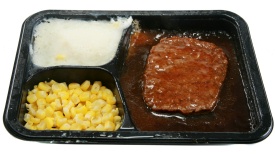When Food is Not Food- Fast and Prepared Foods
How to Avoid Fat Storing Foods

Many grocery items that we regard as food are actually a combination of non-food ingredients. It’s critical to read labels before buying.
You are hungry, but you don’t have much time. You are in a hurry, so you grab something already prepared. Whether you reached for fast food or something prepared from the store, these choices are almost always filled with sodium, sugar, saturated fat, and preservatives. Exactly what your body needs to store more fat.
It’s a decision we have all faced, but, even when it seems like there are no healthy options, there are ways to eat right while on the go. You just need to know how to make better choices when faced with these decisions, and what all this can mean to your health and well-being.
Most people know that almost all fast food is unhealthy. Many fast food restaurants serve food that is loaded with saturated fat, sugar, and sodium. Even when you think you may be choosing the healthy option, you may be consuming more calories and sugar than you should.
An example of this is when you order a salad. If that salad comes with fried, breaded chicken, croutons, cheese, and a full fat dressing, it still is unhealthy, despite the vegetables that it contains. Ordering the same salad with grilled chicken, no croutons or cheese, and a fat-free dressing, is a much more healthy on-the-go option that allows you to stay on track with healthy eating and not have to worry about weight gain.
It’s not just fast food, but also prepared foods, that can appear healthy but actually be a minefield of unhealthy ingredients. Take for example frozen dinners. While some of these may have “healthy” sounding names, like Light or Healthy or Lean, that’s all they are; frozen dinners that are made to sound like they’re good for you.
However, most of them are very high in sodium, preservatives, and artificial dyes and flavors. They also don’t contain enough fruit and vegetables to meet your daily dietary requirements. Adding a side of fresh fruit or vegetables with your frozen meal can help supplement this deficit.
Prepared foods are not always bad for you. In fact, they can be helpful with your weight loss goals and part of a healthy lifestyle. When you know what to look for and how to safely incorporate them, they can give you a quick and easy option for an on-the-go life.
Frozen meals are usually accurate size portions, which means you will be less likely to overeat. They also tend to be low in calories, with most coming in around 300 calories. If you ensure the ones you eat are low in fat, sugar, sodium, and preservatives, they can be part of a healthy lifestyle if they include the equivalent of a serving of vegetables or if you add a side salad.
Along with a lack of vitamins and nutrition, using low calorie prepared meals as the main staple of your diet can cause under eating. Let’s say you eat three 300 calorie meals a day. That is only 900 calories. Too few calories, like too many calories, is detrimental to your health. Not only will you not have enough energy to be active, but eating too few calories will slow your metabolism and thereby making it more difficult for you to lose weight.
Even when choosing prepared meals that are relatively healthy, you still need to be careful. To extend shelf life, these prepared meals often have preservatives and artificial dyes and flavors. While there have been no definitive studies conducted about their effects, there are many claims that they do have harmful side effects.
These claims say that artificial dyes and preservatives are toxic, can cause cancer, and may contribute to anxiety, migraines, and ADHD. It is also worth noting that many European countries, feeling that there is something behind those claims, have banned some artificial dyes, such as yellow #5, that are still commonly used in the United States.
Some U.S. companies have already begun switching from artificial dyes to natural ones, like annatto color from achiote seeds. This switch from yellow #5 to annatto color is especially popular with cheese makers. Since there have been conflicting results from the scientific community, it is best to look for the words “no artificial dyes and preservatives” on the package of any prepared foods that you consume.
By looking for these words, reading labels, choosing healthier options, and supplementing with fresh fruit and vegetables, you will find that some prepared meals can be a quick and healthy part of your life and diet. Fresh is always best, but when you must eat a prepared meal, make it a rare occurrence and an informed choice.
- Published In:
- Living Healthy ,
- Diet Plan for Losing Weight ,
- Healthy Eating
- Tags:
- best diet to lose weight ,
- best ways to lose weight ,
- eat to lose weight ,
- healthy diet ,
- healthy eating ,
- how to lose weight ,
- i need to lose weight ,
- i want to lose weight ,
- lose weight ,
- losing weight ,
- tips for healthy living ,
- weight loss ,
- weight loss tips


